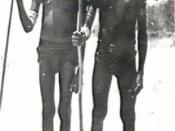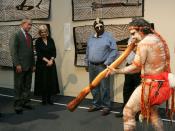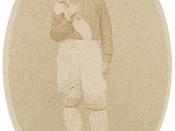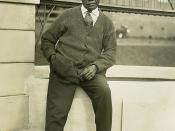QUESTION: How does the Wild Cat Falling involve values, social realism and characterisation?
Texts are often constructed with consideration to the values the author desires to impart upon the reader. This is true for Wild Cat Falling (1965), written by the Aboriginal author Mudrooroo, White Australian reader is made to feel guilty as the life of the main character is introduced to the reader and to the terrible situation he faces in life.
The main charater is not named. He is a half caste. At the start of the text, he is coming out of jail. But he is not excited about it. He hates the society that sent him to jail. The racist society gave him no change to be a good person. As a half-caste, his mother thought that the narrator had the opportunity to have a 'white' life and thus denied him any connection with his Aboriginal cultural connections.
That was a bad idea.
This attempt at assimilation with the whites, did not happen, as the white community rejected him and therefore it is seen that by trying to embrace white culture his mother caused her son's deep sense of alienation and social isolation. She misguided him when she taught him that he was not a Nyoongah. No one should forget their true cultural links.
.
The nameless main character has never known the existence of a sense of belonging. He is like a cloud passing by.
He is isolated in a 'grey area' and is not a part of the Aboriginal or White societies. he sits in FROE jail and is lonely there too. Loneliness is not new to him.
The author uses social realism within the text as he creates a true picture of the unfair social position held by the Aboriginals in Australia. The society in the text, is extremely hostile to him.
He was always treated wrong. When he was nine the narrator stole a dress for his mother and some comics, linen and money due to his poverty. He feels that this is a crime any white boy could have got away with. This child, is taken from his mother and placed in a Christian Brother's institution where he is sad and lonely. This shows how unfair the system was.
The text uses the characterisation of the main character to highlight the aimlessness and purposelessness that the Aboriginal's who attempted assimilation experienced as they felt isolated in the world, unable to find belonging in either of the very different worlds. The narrator is without roots, without a cultural base and the first person point of view the author uses to expose the reader to the narrator's most intimate and personal thoughts helps not only to characterise him but also to highlight his feelings of hopelessness and draw attention to his belief that there is no place for him in society. Directionless, he is disillusioned with life and is filled with a sense of futility. This is seen in his dialogue when he admits to having "accepted hopelessness and futility" (p.3). When he makes his way to the railway station, he drifts "â¦about the platform like one of the stray sheets of newspaperâ¦" (p.47). Embodying his emotional, mental and physical state of 'drifting' the setting of this passage is ironic because at a train station it is implied one has knowledge of one's intended destination, where one is going, and from where one will be coming from. On the contrary, the narrator he no sense of direction, invisible and adrift in a world which doesn't care for him he has been denied any opportunities to give his life meaning or purpose. It is this inability to progress or turn to his heritage or past to direct his actions that sees him entrapped in a vicious cycle of suffering where he inevitably returns to the only manner of living his has ever known, crime. To mask this inner turmoil, he presents a 'so what' attitude which is clearly a pose. This changes when he realises his true identity with the brief guidance and mentorship he experiences from the old Aboriginal at the conclusion of the novel. The central character remains nameless throughout the work and this is indicative of the concept that his social situation and experiences are not localised to his character but universal and therefore representative of the many others who have suffered a similar fate. This encourages an increased awareness amongst readers of the social situation of half-castes. The author's use of characterisation here suggests that it is a literary convention that writer's use to position the reader to view the concept or idea the character's represent or embody.
The discussion above proves that it is true for Mudrooroo's Wild Cat Falling that texts involve values, social realism and characterisation. The author expressed his value of acceptance of who one is and a sense of belonging and used social realism to ensure no romanticisation of the realities of the Aboriginal's suffering at the hands of white oppression, Furthermore, he powerfully characterised a figure which embodied the plight of all Aboriginals in a work contextually relevant to the Western Australian reader.
Bibliography:
Mukurram, Johansson. The world of the Half Cast Canberra University Press, 1989
Abbot, Sean. Living without acceptance Sydney Uni Press, 1980





